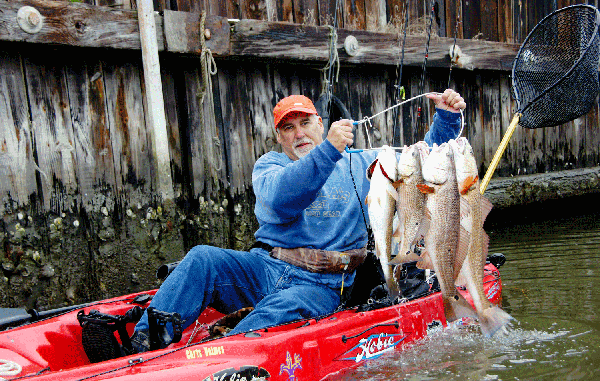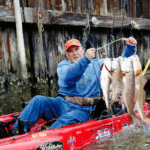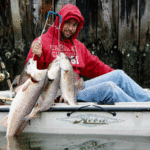
Kayak anglers can find much success pursuing redfish in the cooler months of fall and winter. Redfish are cold-water tolerant and predictable.
If you carefully select your locations and techniques, you can find some very hot cold-water redfish action.
When it comes to cool-weather redfishing, the vast marshes of South Louisiana have all the necessary features to make a successful trip under varying conditions.
For those cold days when redfish are holding deep, fish the bayous, pipelines and dead-end canals. On those warmer days when they move shallower, look for reds in lagoons, ponds and bays.
Many fishermen believe redfish magically appear in the winter marsh. The truth is that they were there all along, but winter conditions tend to concentrate them.
As winter approaches, cold fronts push through South Louisiana, and accompanying northwest winds lower the water throughout the marsh. These usually “cursed” conditions can actually be a boon to kayak anglers: Areas that are too low to be accessed by boat fishermen offer prime fishing opportunities for ’yak anglers.
The low tides allow you to actually see the bottom conditions and structure in given areas. Oyster reefs are readily visible and point the angler to areas where redfish will congregate in low-water conditions.
When the water is low and the temperature cold, redfish pile up in the deeper bayous and dead-end canals. Staking out near an oyster-covered bottom that runs deep into a canal or bayou will usually find redfish stacked on top of each other. They gather here where the deep water provides a warmer, more-stable temperature.
It’s not uncommon to catch and release scores of reds without ever moving the kayak.
Strong winds make for difficult paddling, but also concentrate bait against the windward shoreline. Reds will likely be there to wreak havoc. Finding pockets and coves that receive the wind will generally mean a redfish bonanza.
However, a few days after the passage of a front when the weather stabilizes and warms a bit, redfish will move from their deeper haunts and spread along the shallower bays and shorelines. The bright clear-sky sun quickly radiates through the shallower waters to the dark muddy bottoms, allowing the water to warm by several degrees.
This slight warming of the water temperature will turn redfish into feeding machines.
Redfish are bottom feeders and will root around searching for any critters they can find. They have powerful crushers in their mouths that are great for dispatching their favorite prey of shrimp and crabs.
However, redfish will also eat small fishes, and will readily take artificial baits. Any artificial bait that reasonably resembles food to a redfish will quickly be devoured if cast in their vicinity.
Redfish are not picky eaters.
Known for their quick, drag-burning runs, these bronze brutes can easily test a ’yaker’s stamina. Not only quick, redfish have broad shoulders and their power is evident immediately as you set the hook.
Catching one of these tackle busters in shallow water from a tiny boat is a real treat. The fish will make strong charging runs, oftentimes pulling the kayak with them as they try to gain their freedom.
Redfish will readily take live bait or artificial lures, but dead shrimp is an all-time favorite. Slowly fished Carolina rigged on the bottom or dangling under a popping cork, these natural offerings will easily entice a hungry redfish.
However, for those who prefer the trickery of artificial baits, redfish will readily oblige. Soft-plastic minnow or shrimp imitations, small crankbaits and spinnerbaits will all put redfish on the end of your line.
A major redfish favorite is the weedless gold spoon; redfish can’t resist the wobble and flash of these glittery chunks of metal. Spoons are simple to use, and their streamlined shape and weight make them ideal for casting in strong winter winds.
Although no special tackle is necessary, rods with a little backbone and reels with strong, smooth drags will help quickly subdue feisty redfish.
Rods should be long enough so you can easily maneuver your line back and forth across the bow of the ’yak. Monofilament line in the 12- to 15-pound range is sufficient; however, some anglers prefer to use braided lines. Fishing mono or braid as a main line along with a short length of clear 20-30 pound mono or fluorocarbon leader will help keep reds attached during the battle. Redfish have rough mouths and large, strong, scales and fins, so the heavier leader can withstand the abrasion encountered as the red fights to get away with your offering.
Coastal redfish will range from the small “rat” reds, just under the 16-inch minimum, to tackle-busting bruisers measuring 30-plus inches and weighing 10 pounds or more. These fish offer fantastic action for ’yakers.
Kayakers need to take special precautions for cold weather fishing. The good news is that with proper precautions and clothing, you can safely kayak fish even in the dead of winter. The two main words to remember to prevent loss of body heat are windproof and waterproof. By keeping the wind and water off your body, you will maintain your core body warmth. Select your clothing accordingly.
As the weather gets colder, battling one redfish after another will quickly warm things up. So instead of sitting at home waiting on those warm spring days to come, head to the coastal marsh for some of the hottest kayak fishing around.
Just one battle with these monsters of the marsh, and it will be clear which participant is the one that is really “hooked.”




